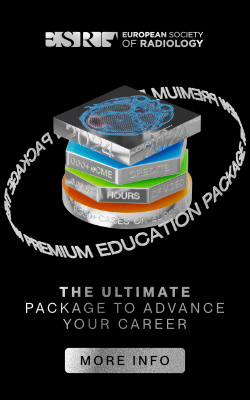Los cambios morfológicos sufridos por el tumor y la pared rectal tras la terapia neoadyuvante hacen que disminuya la precisión de la RM en la estadificación preoperatoria del cáncer de recto.
En nuestro estudio existe una buena correlación entre el GRT valorado por RM y la clasificación histológica de Mandard.
Observamos una “moderada” precisión en la valoración del MRC con una alta sensibilidad (100%) y alto VPN (100%) pero con moderada especificidad (69,8%) y bajo VPP (35%); debido fundamentalmente a la limitación de la técnica para detectar nidos de células tumorales en el espesor del tejido fibrótico.
Independientemente de dichas limitaciones consideramos necesaria la realización de RM postneoadyuvancia ya que nos permitiría seleccionar pacientes respondedores que pudiesen beneficiarse de cirugía menos agresiva de aquellos no respondedores en los que se pudiese plantear terapia adicional prequirúrgica.
BIBLIOGRAFIA
1.Uday B.
Patel,
Fiona Taylor,Lennart Blomqvist,Christopher George,Hywel Evans,ParisTekkis.
Magnetic Resonance Imaging-Detected Tumor Response for Locally Advanced Rectal Cancer Predicts Survival Outcomes: MERCURY Experience.
J Clin Oncol.
Agosto 29 2011.
2.
Brunella Barbaro,
et al Restaging Locally Advanced Rectal Cancer with MR Imaging after Chemoradiation Therapy.RadioGraphics 2010; 30:699–721.
3.Brunella Barbaro et al Locally Advanced Rectal Cancer:MR Imaging in Prediction of Response after Preoperative Chemotherapy and Radiation Therapy Radiology: Volume 250: Number 3—March 2009 730-7394.
4. Steven D Allen et al Rectal Carcinoma: MRI with Histologic Correlation Before and After Chemoradiation Therapy AJR February 2007 vol.
188 no.
2 442-451 Radiology 2008 Feb;246(2):454-62
5.
Vliegen RF et al Mesorectal fascia invasion after neoadjuvant chemotherapy and radiation therapy for locally advanced rectal cancer: accuracy of MR imaging for prediction.
6.
Iris D.
Nagtegaal,
Phil Quirke.
What Is the Role for the Circumferential Margin in the Modern Treatment of Rectal Cancer? JCO January 10,
2008 vol.
26 no. 303-312
7.Roy F.
A.
Vliegen,MD et al.Mesorectal Fascia Invasion after Neoadjuvant Chemotherapy and Radiation Therapy for Locally Advanced Rectal Cancer: Accuracy of MRImaging for Prediction Radiology: Volume 246: Number 2 February 2008 455-462.
8.Dworak O,
Keilholz L,
Hoffmann A.
Pathological features of rectal cancer after preoperative radiochemotherapy.
Int J Colorectal Dis 1997;12:19–23.
9.Hartley A,
Ho K,
McConkey C,
et al.
Pathological complete response following pre-operative chemoradiotherapy in rectal cancer: analysis of phase II/III trials.
Br J Radiol 2005;78:934–938.
10.
Bonnen M,
Crane C,
Vauthey J,
et al.
Longterm results using local excision after preoperative chemoradiation among selected T3 cancer patients.
Int J Radiat Oncol Biol Phys 2004;60:1098–1105.
11.Habr-Gama A,
Perez R,
Nadalin W,
et al.Operative versus nonoperative treatment for stage 0 distal rectal cancer following chemoradiation therapy: long-term results.
Ann Surg 2004;240:711–717.
12.
Beets-Tan RGH,
Beets GL,
Vliegen RFA,
Kessels AGH,
Van Boven H,
De Bruine A,
et al.
Accuracy of magnetic resonance imaging in prediction of tumour-free resection margin in rectal cancer surgery.
Lancet 2001; 357: 497-504.
13.Marthur P,
Smith JJ,
Ramsey C,
Owen,
Thorpe A,
et al.
Comparison of CT and MRI in the preoperative staging of rectal adenocarcinoma and prediction of circunferential resection margin involvement by MRI. Colorectal disease,
396-401.
14.- Bipart S,GlasAS,
Slors FJM,
Zwinderman AH,
Bossuyt PMM,
Stoker J.
Rectal Cancer: Local Staging and Assessment of Limph Node Involvement with EndoluminalUS,
CT,and MR Imaging—A Meta-Analisis.
Radiology 2004; 232:773-783.
15.Brown G,
KirKham A,
Williams GT,
Bourne M,
Radcliffe AG,
Sayman J,
Nevell R,
Sinnatamby CH,
Heald RJ.
High-Resolution MRI of the Anatomy Important in Total Mesorectal Excision of the Rectum.AJR 2004;182: 431-439.
16.Kuang Goh JS,
Nam Goh JP,
In Wansacheong GK.
Methylcellulose as a Rectal Contrast Agent for MR Imaging of Rectal Carcinoma.
AJR: 178,
May 2002.
17.Brown G,
Richards CJ,
Bourne MW,
Newcombe RG,
Radcliffe AG,
Dallimore NS,
Williams GT.
Morphologic predictors of Lymph Node Status in Rectal Cancer with Use of High-Spatial-Resolution MR Imaging with Histopathologic Comparison.
Radiology 2003; 227: 371-377.
18.Koh D-M,
Brown G,
Temple L,
Raja A,
Toomey P,
Bett N,
Norman AR,
Husband JE.
Rectal Cancer: Mesorectal Lymph Nodes at MR Imaging with USPIO versus Hitopathologic Findins Initials Observations.
Radiology 2004; 231:91-99.
19.- Sagar PM,
Pemberton JH.
Surigical management of locally recurrent rectal cancer.
Br.
J.
Surgery2003; 90: 355-364.
20.Quirke P,
Durdey P,
DixonMF,
WillliamsNS.
Local recurrence of rectal adenocarcinoma due to inadequate surgical resection.
Histopathological study of lateral tumour spread and surgical excision.
Lancet 1986; 996-9
21.- Heald RJ,
Ryall RD.
Recurrence and survival after total mesorectal excision for rectal cancer.
Lancet 1986; 1: 1479-82.
22.Swedish Rectal Cancer Trial investigators.
Improved survival with preoperative radiotherapy in resectable rectal cancer.
Swedish Rectal Cancer Trial.
N.
Engl.
J.
Med 1997; 336: 980-7.
23.Beets-Tan RGH.
MRI in rectal cancer: The T stage and circumferential resection margin.
Colorectal Disease 5: 392-395.
24.Brown G,
Radcliffe A.G.,
Newcombe RG,
DallimoreNS,
Bourne MW,
Williams G.T.
Preoperative assessment of prognostic factors in rectal cancer using high-resolution magnetic resonance imaging.
British Journal of Surgery 2003; 90: 355-364.


